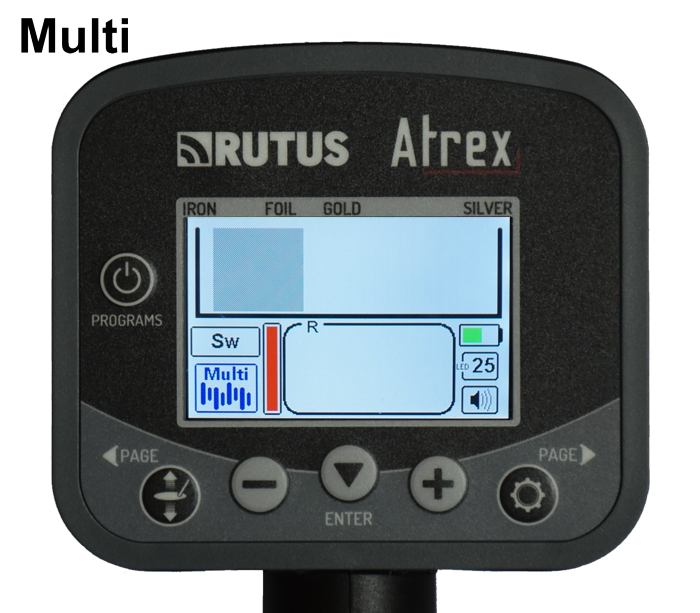
Rutus Atrex is a metal detector where you can decide how advanced software you want to use. If you are a beginner or like "plug and go" devices, then we recommend the "Basic" mode. If you require full control of the detector, then "Multi" mode is recommended.

Rutus Atrex is a metal detector where you can decide how advanced software you want to use. If you are a beginner or like "plug and go" devices, then we recommend the "Basic" mode. If you require full control of the detector, then "Multi" mode is recommended.
Atrex comes with the "Multi" software pre-installed. You can download the basic version from the website and install it yourself thanks to the built-in WiFi module. The multi-frequency technology used by the detector improves the detection performance of the detector in both wet and conductive soils, e.g. beaches, and soils with high magnetite content. With Atrex you can search in all soil conditions from classic forests and fields to salty beaches.
Rutus Atrex uses the Multifilter function which works in the background of the detector. It significantly increases the efficiency of detecting non-ferrous objects in highly mineralized soils. The new colour display is very little susceptible to the effects of low temperatures and always works just as fast. The new OS-2 wireless receiver and SR-1 wireless headset work with the Atrex.

SPECIFICATIONS

MULTI SOFTWARE (factory version)

BASIC SOFTWARE (download)

Multifrequency in the Atrex detector, as described by Rutus engineers
Atrex currently has a Water Reject feature, which is the simplest use of more than one frequency for operation in a metal detector. The transmit signal is not specially shaped, we simply take advantage of the natural presence of harmonic frequencies in a rectangular signal.
Research and experimentation on actually working with multiple frequencies has been going on at RUTUS for a long time. The Atrex has, for good reason, a processor three times more powerful than the one we used in previous models, and a similar but different design for the detector electronics themselves.
The first most important point is the number of frequencies. You will often see in various materials how many frequencies Multi Frequency detectors transmit. The important thing is not how many frequencies the detector transmits, but how many it RECEIVES i.e. how many frequencies it analyses simultaneously to detect an object. Transmitting a frequency that the detector does not receive is just a waste of energy.
The transmit signal must be optimized to transmit ONLY those frequencies that the detector receives and this issue is complex in itself.Simply described, single frequency detectors use a resistive signal to detect objects ("Y"), while Multi Frequency detectors use magnetic ("X") signals from multiple frequencies.
The X signals behave differently from the picture we are all familiar with. How many frequencies will the Atrex instrument work with in Multi Frequency mode? As many as are needed to achieve all the desired functions. This information is part of each company's closely guarded know-how.
Another persistent myth to deal with is that the detector in Multi Frequency is "slow". Today, Multi Frequency design does not mean "slow" and has a number of advantages:
